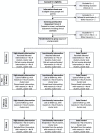A randomised controlled trial of energetic activity for depression in young people (READY): a multi-site feasibility trial protocol
- PMID: 33390189
- PMCID: PMC7779325
- DOI: 10.1186/s40814-020-00734-7
A randomised controlled trial of energetic activity for depression in young people (READY): a multi-site feasibility trial protocol
Abstract
Background: Prevalence of depression is increasing in young people, and there is a need to develop and evaluate behavioural interventions which may provide benefits equal to or greater than talking therapies or pharmacological alternatives. Exercise could be beneficial for young people living with depression, but robust, large-scale trials of effectiveness and the impact of exercise intensity are lacking. This study aims to test whether a randomised controlled trial (RCT) of an intervention targeting young people living with depression is feasible by determining whether it is possible to recruit and retain young people, develop and deliver the intervention as planned, and evaluate training and delivery.
Methods: The design is a three-arm cluster randomised controlled feasibility trial with embedded process evaluation. Participants will be help-seeking young people, aged 13-17 years experiencing mild to moderate low mood or depression, referred from three counties in England. The intervention will be delivered by registered exercise professionals, supported by mental health support workers, twice a week for 12 weeks. The three arms will be high-intensity exercise, low-intensity exercise, and a social activity control. All arms will receive a 'healthy living' behaviour change session prior to each exercise session and the two exercise groups are energy matched. The outcomes are referral, recruitment, and retention rates; attendance at exercise sessions; adherence to and ability to reach intensity during exercise sessions; proportions of missing data; adverse events, all measured at baseline, 3, and 6 months; resource use; and reach and representativeness.
Discussion: UK National Health Service (NHS) policy is to provide young people with advice about using exercise to help depression but there is no evidence-based exercise intervention to either complement or as an alternative to medication or talking therapies. UK National Institute for Health and Care Excellence (NICE) guidelines suggest that exercise can be an effective treatment, but the evidence base is relatively weak. This feasibility trial will provide evidence about whether it is feasible to recruit and retain young people to a full RCT to assess the effectiveness and cost-effectiveness of an exercise intervention for depression.
Trial registration: ISRCTN, ISRCTN66452702 . Registered 9 April 2020.
Keywords: Behaviour change; Depression; Exercise; Feasibility trial; Low mood; Physical activity; Young people.
Conflict of interest statement
The authors declare that they have no competing interests.
Similar articles
-
Folic acid supplementation and malaria susceptibility and severity among people taking antifolate antimalarial drugs in endemic areas.Cochrane Database Syst Rev. 2022 Feb 1;2(2022):CD014217. doi: 10.1002/14651858.CD014217. Cochrane Database Syst Rev. 2022. PMID: 36321557 Free PMC article.
-
Behavioural activation therapy for post-stroke depression: the BEADS feasibility RCT.Health Technol Assess. 2019 Sep;23(47):1-176. doi: 10.3310/hta23470. Health Technol Assess. 2019. PMID: 31524133 Free PMC article. Clinical Trial.
-
Acceptance and commitment therapy for older people with treatment-resistant generalised anxiety disorder: the FACTOID feasibility study.Health Technol Assess. 2021 Sep;25(54):1-150. doi: 10.3310/hta25540. Health Technol Assess. 2021. PMID: 34542399 Clinical Trial.
-
Community Occupational Therapy in Dementia intervention for people with mild to moderate dementia and their family carers in the UK: the VALID research programme including RCT.Southampton (UK): National Institute for Health and Care Research; 2023 Jun. Southampton (UK): National Institute for Health and Care Research; 2023 Jun. PMID: 37463269 Free Books & Documents. Review.
-
Digital interventions for hypertension and asthma to support patient self-management in primary care: the DIPSS research programme including two RCTs [Internet].Southampton (UK): National Institute for Health and Care Research; 2022 Dec. Southampton (UK): National Institute for Health and Care Research; 2022 Dec. PMID: 36538606 Free Books & Documents. Review.
Cited by
-
Moderate-to-vigorous group aerobic exercise versus group leisure activities for mild-to-moderate depression in adolescents: study protocol for a multicentre randomised controlled trial.BMJ Open. 2022 Jul 12;12(7):e060159. doi: 10.1136/bmjopen-2021-060159. BMJ Open. 2022. PMID: 35820753 Free PMC article.
References
-
- Birmaher B, Brent D, A.W.G.o.Q. Issues. Practice parameter for the assessment and treatment of children and adolescents with depressive disorders. J Am Acad Child Adolesc Psychiatr. 2007;46(11):1503-1526. - PubMed
Grants and funding
LinkOut - more resources
Full Text Sources
Other Literature Sources
Miscellaneous


